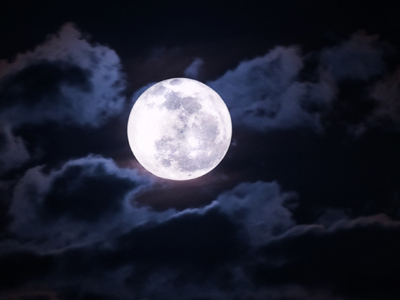
Ask the AI Tutor
Need help with Earth, Moon and Sun? Ask our AI Tutor!
AI Tutor - Lucy
Connecting with Tutor...
Please wait while we establish connection

The moon is full when the sunlit hemisphere is completely facing the Earth.
Earth, Moon and Sun
The Earth moves around the Sun, creating days, nights, and seasons. Learning about space helps us understand our place in the universe.
1 .
Which of the following lasts approximately 24 hours?
The Earth's orbit of the Sun
A full rotation of the Earth on its axis
The Sun's orbit of the Earth
The Moon's orbit of the Earth
24 hours is the length of one day and is caused by the Earth spinning (rotating) on its axis. Remember: the Sun does not orbit the Earth!
2 .
When is the Moon full?
When it's the first day of the month
When the sunlit hemisphere is completely facing the Earth
When the dark side of the Moon is completely facing Earth
When it's the last day of the month
When the dark hemisphere of the moon is completely facing the Earth, it is described as a new moon
3 .
What causes a lunar eclipse?
The Sun blocks our view of the Moon
The Earth blocks the Sun's light from reaching the Moon
The Moon blocks our view of the Sun
The Earth blocks the Moon's rays from reaching the Sun
Lunar eclipses last a few hours. It's completely safe to look at the Moon during an eclipse without using eye protection - of course, you must never look directly at a solar eclipse (which is when the Moon blocks our view of the Sun for a few minutes)
4 .
Which of the following lasts approximately 28 days?
The Earth's orbit of the Sun
The Sun's orbit of the galaxy
The Earth's orbit of the Moon
The Moon's orbit of the Earth
The Moon takes approximately 28 days to travel around the Earth. It also takes approximately 28 days to rotate on its own axis
5 .
Which celestial body is the Earth closest to?
The Moon
The Sun
Mars
Venus
The Moon is only 239,000 miles away from the Earth. In space terms, that makes the Moon our next-door neighbour!
6 .
Why does the Moon look different during its different phases?
The Earth's shadow sometimes blocks the Sun's light from reaching the Moon
One side of the Moon is not as reflective as the other side
Different parts of the sunlit side of the Moon become visible as it makes its orbit around Earth
The Sun's gravity causes the Moon to change its shape
Only one half (one hemisphere) of the moon is lit by the Sun, just as only one half of the Earth at any one time is lit by the Sun - on the other side it is night-time, and dark. Because the Moon is continuously orbiting, we can't always see all of its sunlit hemisphere from the Earth
7 .
Which of these orbits the Earth?
The Sun
The Moon
The Earth's axis
The North and South Poles
The Moon is the Earth's natural satellite, which means it orbits the Earth
8 .
Which one of the following is NOT a phase of the moon?
Full moon
First Quarter
New moon
Blue moon
The Moon also passes through a Last Quarter phase, as well as Crescent (less than half full) and Gibbous (more than half full) phases
9 .
Which of the following is a planet?
The Earth
The Moon
The Sun
All of the above
The Sun is a star and the Moon is a moon
10 .
Which of the following is false?
The Earth's orbit of the Sun causes seasons
The Earth's rotation causes day and night
The Moon's orbit causes its shape to change
The Moon's orbit causes its appearance to change
The Moon's shape doesn't change - it is always near-spherical - instead, its appearance changes throughout its 28 day orbit as different parts of it are in shadow
**Unlimited Quizzes Await You! 🚀**
Hey there, quiz champ! 🌟 You've already tackled today's free questions.
Ready for more?
Ready for more?
🔓 Unlock UNLIMITED Quizzes and challenge yourself every day. But that's
not all...
not all...
🔥 As a Subscriber you can join our thrilling "Daily Streak" against other
quizzers. Try to win a coveted spot on our Hall of Fame Page.
quizzers. Try to win a coveted spot on our Hall of Fame Page.
Don't miss out! Join us now and keep the fun rolling. 🎉
**Unlimited Quizzes Await You! 🚀**
Hey there, quiz champ! 🌟 You've already tackled today's free questions. Ready for more?
🔓 Unlock UNLIMITED Quizzes and challenge yourself every day. But that's not all...
🔥 As a Subscriber you can join our thrilling "Daily Streak" against other quizzers. Try to win a coveted spot on our Hall of Fame Page.
Don't miss out! Join us now and keep the fun rolling. 🎉






